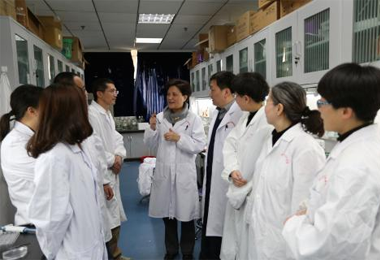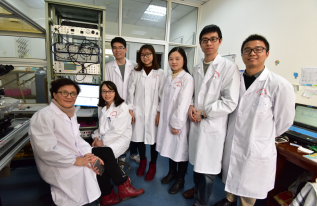----Alzheimer’s Disease
A. Team Introduction
Academic leader:  Prof. Dr. WANG Jianzhi, prominent professor with outstanding accomplishment in Neurology, pathophysiology and bio-neuropathology, Director of Pathophysiology Key Laboratory of Chinese Ministry of Education, focusing on Alzheimer’s disease including pathogenesis, early diagnosis and prevention; also interested in emotion and learning memory, neurodevelopment and neural circuitry. She was selected by the National Ten Thousand Talents Plan, and awarded as Creative Team Leader for Neurological Disorders, National Model Teacher for Education, National Prestigious Teacher Award for Teaching, Changjiang Distinguished Professor of Ministry of Education of China etc.
Prof. Dr. WANG Jianzhi, prominent professor with outstanding accomplishment in Neurology, pathophysiology and bio-neuropathology, Director of Pathophysiology Key Laboratory of Chinese Ministry of Education, focusing on Alzheimer’s disease including pathogenesis, early diagnosis and prevention; also interested in emotion and learning memory, neurodevelopment and neural circuitry. She was selected by the National Ten Thousand Talents Plan, and awarded as Creative Team Leader for Neurological Disorders, National Model Teacher for Education, National Prestigious Teacher Award for Teaching, Changjiang Distinguished Professor of Ministry of Education of China etc.
B. Team Members:
Prof. Wang Xiaochuan:
Professor, doctoral tutor, member of the Communist Party of China. He was selected in the New Century Excellent Talent Support Program and became the youth academic leader of the Key Laboratory of Neurological Diseases of the Ministry of Education in 2007. Since 2000, he has been devoted to the basic research of Alzheimer's disease (AD), and has been carried out a series of studies in the etiology, pathogenesis, early diagnosis, animal model and prevention strategies of the AD. As a principle investigator, he has received seven national grants and has published over 50 high impact research papers
Prof. Zhou Xinwen:
Professor of Pathophysiology, research interests focus on the mechanisms and molecular markers for Alzheimer disease and other psychiatric disorders. He has received several national grants and has published over 30 research papers in peer reviewer journals, including Mol Neurobiol, Brain Res, J Alzheimers Dis, Age (Dordr), Cell Death Dis, Neurobiol Aging and Neurobiol Dis.
Prof. Liu Gongping:
male, professor of Pathophysiology, awardee of New Century Excellent Talents Project conducted by the Chinese Ministry of Education, research interests focus on the mechanism and molecular targets for neurodegeneration. He has been awarded of several national grants and has published over 40 SCI research papers.
Prof. Liu Rong:
Ph.D.in Pathophysiology, M.D., full professor, awardee of Outstanding Young Scientist of Hubei province, research interests focus on the role and mechanism of environmental factors in promoting neurological diseases such as Alzheimer disease, stroke and depression. She has been awarded of four national grants and has published over 20 high impact research papers in journals such as Molecular Psychiatry, Cell Death Dis, J Biol Chem. Detailed information: http://english.tjmu.edu.cn/info/1027/1112.htm
Prof. Yang Ying:
Ph.D in pathophysiology, associate professor, focusing on the neural circuit mechanisms for how emotional states influence behavior in health and disease. She has received several national grants and has published over 10 research papers, including Neuron and Nature Communications.

C. Key Research Direction
Pathogenesis, early diagnostic and therapeutic strategies for Alzheimer disease and the related disorders.
D. Background and Significance
Alzheimer disease (AD) is the most common, age-related disorder characterized by progressive neurodegeneration and memory loss. The incidence of AD is dramatically increasing with the increased aging population. To date, AD cannot be definitely diagnosed in early stage, and there is not drug to cure the disease or even just delay the disease progression. The research aim of the team has been focused on the pathogenesis and early diagnostic and therapeutic strategies of AD by using cutting-edge technologies.
E. Research Achievements, Awards, Publications
Research Achievements:
1. They have found that the cytoskeleton protein tau has also functions in regulating cell viability, i.e., the tau hyperphosphorylation leads the cells escape apoptosis. Simultaneously, the intracellular accumulation of the hyperphosphorylated tau impairs neural functions. Based on these findings, they have proposed a novel model for Alzheimer neurodegeneration and tauopathies.
2. They have identified several molecular markers/signaling pathways in regulating posttranslational modifications and accumulation of tau proteins, and in turn effects of the accumulated tau on the cellular metabolisms and the functions, by which they have provided new insights for the pathogenesis and potential interventions for Alzheimer disease.
3. They also identified a neural circuit between pBLA to vCA1, and found that this excitatory monosynaptic circuit plays a crucial role in mediating “hopefulness” and “hopelessness” emotions and learning memory.
Selected Funds:
1. Molecular mechanisms underlying Alzheimer’s neurodegeneration. NSFC, 2017.08-2021. 07. Principle Investigator
2. Impairment of medial septum-hippocampus cholinergic circuit in Alzheimer’s spatial memory deficit and the molecular mechanisms. NSFC, 2017.01-2019. 12. Principle Investigator
3. AEP cleaved tau toxicities. NSFC, 2016.01-2017. 12. Principle Investigator
4. Mechanisms and risk factors of Alzheimer’s disease. Ministry of Science and Technology of the People’s Republic of China, 2016.09-2021.08, Principle Investigator
Selected Research Awards:
1. Molecular Mechanisms Underlie Alzheimer-like Tau Hyperphosphorylation and Neurodegeneration; Second Prize of the National Natural Science Award; Year 2010; Certificate No:2010-Z-106-2-01-R01
2. Mechanisms of Tau Hyperphosphorylation and Its Effect on the Survival of Neurons; First Prize of Higher Institution’s Natural Science Award; Year 2009; Certificate No :2008-029
3. Effect and Clinical Significance of Abnormal Cytoskeleton Proteins in Pathogenesis of AD; First Prize of National Science and Technology Award Nominated by the Ministry of Education; Year 2005; Certificate No :2004-028
4. Effect and Potential Value of GSK-3 in Alzheimer-like Tau Hyperphosphorylation;First Prize of Hubei Provincial Natural Science Award; Year 2008; Certificate No :2008Z-028-1-006-004-R01
5. Abnormal Modification of Cytoskeletal Proteins and Its Mechanism in Alzheimer Disease; First-Class Prize of Chinese Medical Science and Technology Award; Year 2002; Certificate No :200201050P0501
Selected Publications
1.Wang ZH, Gong K, Liu X, Zhang ZT, Sun X, Wei Z, Yu S, Manfredsson FP, Sandoval I, Johnson P, Jia J, Wang JZ*, Ye K*. C/EBPβ regulates Delta-secretase expression and mediates pathogenesis in mouse models of Alzheimer’s Disease". Nat Commun. Accepted.
2. Wang ZH, Liu P, Liu X, Manfredsson FP, Sandoval IM, Yu SP, Wang JZ*, Ye K*. Delta-Secretase Phosphorylation by SRPK2 Enhances Its Enzymatic Activity, Provoking Pathogenesis in Alzheimer's Disease. Mol Cell. 2017 Sep 7;67(5):812-825.e5. doi: 10.1016/j.molcel.2017.07.018. Epub 2017 Aug 17.
3. Zhang Z, Kang SS, Liu X, Zhang Z, He l, Iuvone PM, Duong DM, Seyfried NT, Benskey MJ, Manfredsoon FP, Jin L*, Sun YE, Wang JZ*, Ye K*. Asparagine endopeptidase cleaves synuclein and mediates its pathological activities in Parkinson disease. Nature Structural & Molecular Biology. 2017 Jul 3. doi: 10.1038/nsmb.3433. [Epub ahead of print]
4. Zhang Z, Obianyo O, Dall E, Du Y, Fu H, Liu X, Kang SS, Song M, Yu SP, Cabrele C, Schubert M, Li X, Wang JZ*, Brandstetter H*, Ye K*. Inhibition of delta-secretase improves cognitive functions in mouse models of Alzheimer's disease. Nat Commun. 2017 Mar 27;8:14740. doi: 10.1038/ncomms14740.
5. Li XG, Wang ZH, Tan L, Wang YL, Lu C, Chen R, Zhang SJ, Gao Y, Liu YC, Yin YL, Liu XH, Liu EJ, Yang Y, Hu Y, Xu ZP, Xu FQ, Wang J, Liu GP*, Wang JZ*. Correcting miR92a-vGAT-mediated GABAergic dysfunctions rescues human tau-induced anxiety in mice. Mol Ther. 2017 25(1):140-152.
6.Tuo QZ, Lei P*, Jackman KA, Li XL, Xiong H, Li XL, Liuyang ZY, Roisman L, Zhang ST, Ayton S, Wang Q, Crouch PJ, Ganio K, Wang XC, Pei L, Adlard PA, Lu YM, Cappai R, Wang JZ, Liu R*, Bush AI*. Tau-mediated iron export prevents ferroptotic damage after ischemic stroke. Mol Psychiatry. 2017 Nov;22(11):1520-1530. doi:10.1038/mp.2017.171
7. Yang Y, Wang ZH, Jin S, Gao D, Liu N, Chen SH, Zhang S, Liu Q, Liu E, Wang X, Liang L, Wei P, Li X, Li Y, Yue C, Li HL, Wang YL, Wang Q, Ke D, Xie Q, Xu F, Wang L*, Wang JZ*. Opposite monosynaptic scaling of BLP–vCA1 inputs governs hopefulness– and helplessness–modulated spatial learning and memory. Nat Commun. 2016;7:11935. doi:10.1038/ncomms11935.
8. Yin Y, Gao D, Wang Y, Wang ZH, Wang X, Ye J, Wu D, Fang L, Pi G, Yang Y, Wang XC, Lu C, Ye K, Wang JZ*. Tau accumulation induces synaptic impairment and memory deficit by calcineurin-mediated inactivation of nuclear CaMKIV/CREB signaling. Proc Natl Acad Sci U S A. 2016 Jun 28;113(26):E3773-81.
Research Patents
1. Name: Neurotrophic factor fusion peptide of brain targeting for resisting Alzheimer; Disease and its Preparation Method; Approval year: 2012; Patent no:ZL201010210143.7
2. Name: Fusion Polypeptide crossing the blood-brain barrier to resist Alzheimer Disease; Approval year: 2012; Patent no:ZL201010182630.7

Team Contact: Dr. KE Dan, kedan@hust.edu.cn
